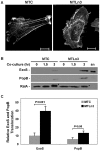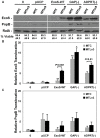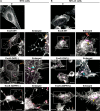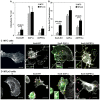Metastatic MTLn3 and non-metastatic MTC adenocarcinoma cells can be differentiated by Pseudomonas aeruginosa
- PMID: 24143275
- PMCID: PMC3773335
- DOI: 10.1242/bio.20133632
Metastatic MTLn3 and non-metastatic MTC adenocarcinoma cells can be differentiated by Pseudomonas aeruginosa
Abstract
Cancer patients are known to be highly susceptible to Pseudomonas aeruginosa (Pa) infection, but it remains unknown whether alterations at the tumor cell level can contribute to infection. This study explored how cellular changes associated with tumor metastasis influence Pa infection using highly metastatic MTLn3 cells and non-metastatic MTC cells as cell culture models. MTLn3 cells were found to be more sensitive to Pa infection than MTC cells based on increased translocation of the type III secretion effector, ExoS, into MTLn3 cells. Subsequent studies found that higher levels of ExoS translocation into MTLn3 cells related to Pa entry and secretion of ExoS within MTLn3 cells, rather than conventional ExoS translocation by external Pa. ExoS includes both Rho GTPase activating protein (GAP) and ADP-ribosyltransferase (ADPRT) enzyme activities, and differences in MTLn3 and MTC cell responsiveness to ExoS were found to relate to the targeting of ExoS-GAP activity to Rho GTPases. MTLn3 cell migration is mediated by RhoA activation at the leading edge, and inhibition of RhoA activity decreased ExoS translocation into MTLn3 cells to levels similar to those of MTC cells. The ability of Pa to be internalized and transfer ExoS more efficiently in association with Rho activation during tumor metastasis confirms that alterations in cell migration that occur in conjunction with tumor metastasis contribute to Pa infection in cancer patients. This study also raises the possibility that Pa might serve as a biological tool for dissecting or detecting cellular alterations associated with tumor metastasis.
Keywords: Cell migration; MTC and MTLn3 cells; Pseudomonas aeruginosa; Rho GTPase; Tumor metastasis.
Conflict of interest statement
Figures





Similar articles
-
Examining the role of actin-plasma membrane association in Pseudomonas aeruginosa infection and type III secretion translocation in migratory T24 epithelial cells.Infect Immun. 2012 Sep;80(9):3049-64. doi: 10.1128/IAI.00231-12. Epub 2012 Jun 11. Infect Immun. 2012. PMID: 22689823 Free PMC article.
-
Independent and coordinate effects of ADP-ribosyltransferase and GTPase-activating activities of exoenzyme S on HT-29 epithelial cell function.Infect Immun. 2001 Sep;69(9):5318-28. doi: 10.1128/IAI.69.9.5318-5328.2001. Infect Immun. 2001. PMID: 11500401 Free PMC article.
-
Characterization of Pseudomonas aeruginosa exoenzyme S as a bifunctional enzyme in J774A.1 macrophages.Infect Immun. 2003 Sep;71(9):5296-305. doi: 10.1128/IAI.71.9.5296-5305.2003. Infect Immun. 2003. PMID: 12933877 Free PMC article.
-
Pseudomonas aeruginosa exoenzyme S, a bifunctional type-III secreted cytotoxin.Int J Med Microbiol. 2000 Oct;290(4-5):381-7. doi: 10.1016/S1438-4221(00)80047-8. Int J Med Microbiol. 2000. PMID: 11111915 Review.
-
Pseudomonas aeruginosa ExoS and ExoT.Rev Physiol Biochem Pharmacol. 2004;152:79-92. doi: 10.1007/s10254-004-0031-7. Epub 2004 Aug 24. Rev Physiol Biochem Pharmacol. 2004. PMID: 15375697 Review.
Cited by
-
Cell-type-specific hypertranslocation of effectors by the Pseudomonas aeruginosa type III secretion system.Mol Microbiol. 2021 Feb;115(2):305-319. doi: 10.1111/mmi.14617. Epub 2020 Nov 5. Mol Microbiol. 2021. PMID: 33012037 Free PMC article.
References
Grants and funding
LinkOut - more resources
Full Text Sources
Other Literature Sources
Miscellaneous

